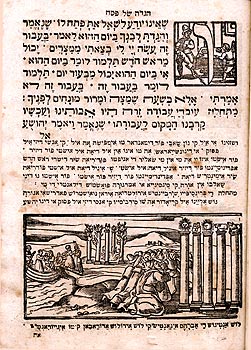


 |
Collection Jacob M. Lowy
Hagadah. Hébreu et judéo-espagnol. Seder Hagadah shel Pesah 'im ha-pitron be-lashon Sefaradi. Livorno (Livourne, Toscane) : bi-defus shel Nahman Sa'adun, 585 [1825].
Livourne était une importante ville portuaire d'Italie pour les pays de l'Atlantique, de la Méditerranée et de l'Est qui faisaient entre eux des échanges commerciaux. À partir de la fin du XVIe siècle, elle attira particulièrement les Juifs convertis de l'Espagne et du Portugal qui désiraient pratiquer de nouveau et ouvertement le judaïsme. Nahman Sa'adun produisit cette Hagadah avec sa traduction judéo-espagnole et les instructions qui l'accompagnent à l'intention de la diaspora éloignée de langue judéo-espagnole. Le livre est ouvert sur un récit narratif rédigé sur les quatre fils, chacun desquels incorpore une réponse différente relative à son héritage. En bas, à gauche, on peut voir une gravure sur bois des ancêtres d'Abraham vénérant des idoles alors qu'Abraham, à bord du bateau, quitte Ur pour Canaan.
Leghorn was an important Italian port city for commercial trade among Atlantic, Mediterranean and Eastern countries. From the late 16th century it especially attracted the converted Jews of Spain and Portugal, who wished to practice Judaism again openly. Nahman Sa'adun produced this Hagadah with Judeo-Spanish translation and instructions for the far flung Judeo-Spanish speaking diaspora. The text is open to the narrative of the four sons, each of whom embodies a different response toward his heritage. At bottom left, there is a woodcut of Abraham's ancestors worshipping idols, while Abraham, in the boat, departs Ur for Canaan.
